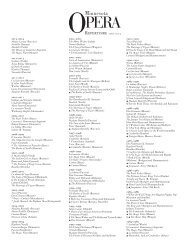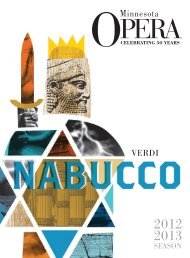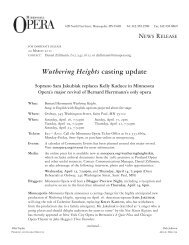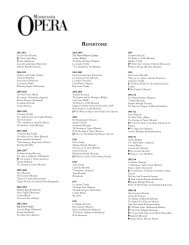Create successful ePaper yourself
Turn your PDF publications into a flip-book with our unique Google optimized e-Paper software.
History of the <strong>Minnesota</strong> <strong>Opera</strong><br />
<strong>Minnesota</strong> <strong>Opera</strong> combines a culture of creativity and fiscal responsibility to produce opera<br />
and opera education programs that expand the art form, nurture artists, enrich audiences<br />
and contribute to the vitality of the community.<br />
<strong>Minnesota</strong> <strong>Opera</strong>’s roots were planted in 1963 when the Walker Art Center<br />
commissioned Dominick Argento to compose an opera (The Masque of Angels) for<br />
its performing arts program, Center <strong>Opera</strong>. Center <strong>Opera</strong> focused on the<br />
composition and performance of new works by American composers, and, under<br />
the influence of the Walker Art Center, emphasized visual design. The company<br />
grew steadily, and in 1969 became an independent entity, changing its name in<br />
1971 to The <strong>Minnesota</strong> <strong>Opera</strong>.<br />
Throughout the first 12 years of its history, The <strong>Minnesota</strong> <strong>Opera</strong> was known as a progressive, “alternative” opera<br />
production company, a complement to the traditional orientation of the annual Metropolitan <strong>Opera</strong> tour and the<br />
productions of the St. Paul <strong>Opera</strong>. In 1976, The <strong>Minnesota</strong> <strong>Opera</strong> merged with the St. Paul <strong>Opera</strong>, adding a focus on<br />
traditional repertory to its program of contemporary opera.<br />
Set design for <strong>Minnesota</strong> <strong>Opera</strong>’s<br />
1971 production of Dominick Argento’s<br />
Postcard from Morocco<br />
In January 1985, The <strong>Minnesota</strong> <strong>Opera</strong> entered a new era with the opening of<br />
the Ordway Center for the Performing Arts in St. Paul, one of the nation’s most<br />
respected performance halls. Today, the company presents its entire season at the<br />
Ordway.<br />
In September 1990, the company moved its scenic and costume shops, rehearsal<br />
facilities and administrative offices to the 51,000 square-feet <strong>Minnesota</strong> <strong>Opera</strong><br />
Center, which comprises three renovated warehouses on the Mississippi<br />
riverfront in Minneapolis. Winner of a 1990 Preservation Alliance of <strong>Minnesota</strong><br />
Award, the <strong>Minnesota</strong> <strong>Opera</strong> Center is one of the finest opera production<br />
facilities in the nation and has served to strengthen the company both artistically<br />
and institutionally.<br />
Throughout the 1990s, the company gained a national reputation for its high-quality, innovative productions of standard<br />
repertoire operas like Aida, Carmen and Turandot, which were seen on stages across the nation, and firmly established<br />
<strong>Minnesota</strong> <strong>Opera</strong>’s reputation as a lead coproducer in the industry. In that decade, <strong>Minnesota</strong> <strong>Opera</strong> also grew<br />
institutionally, launching an artistic development campaign to establish a foundation for the expansion of its season and<br />
increased artistic quality.<br />
In 1997, the company launched its Resident Artist Program to bridge the gap between an artist’s academic training and<br />
their professional life on the world stage. The RAP is acclaimed for its exceptional, intense and individualized training as<br />
well as the elite group of young artists it produces. Alumni<br />
have earned engagements at prestigious houses such as the<br />
Metropolitan <strong>Opera</strong>, the Salzburg Festival and Covent Garden.<br />
In 2000, Artistic Director Dale Johnson articulated a new<br />
artistic vision for the company inspired by bel canto (“beautiful<br />
singing”), the ideal upon which Italian opera is based. Bel canto<br />
values, which emphasize intense emotional expression<br />
supported by exquisite technique, inform every aspect of the<br />
company’s programs, from repertoire selection, casting and<br />
visual design to education and artist training. As one<br />
manifestation of its philosophy, <strong>Minnesota</strong> <strong>Opera</strong> is committed<br />
to producing one work from the early 19 th -century Bel Canto<br />
period each season, attracting luminary singers like Bruce Ford,<br />
Vivica Genaux, Brenda Harris and Sumi Jo to its stage.<br />
A scene from <strong>Minnesota</strong> <strong>Opera</strong>’s 1984 production of<br />
Peter Schickele’s The Abduction of Figaro<br />
history of the minnesota opera 94








